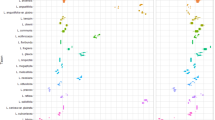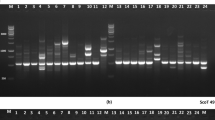Abstract
Cultivated (Citrullus lanatus var. lanatus) and citron type (var. citroides) watermelon collected from different areas on the African continent are remarkably diverse in fruit and seed morphology. Chloroplast DNA investigations using PCR-RFLP and sequencing analysis of several non-coding regions were conducted to infer their biogeographic and evolutionary relationships, origin and domestication history. Variability within C. lanatus was observed at regions of high A + T content, resulting in indels and transversions mainly. Distinct chlorotype lineages were identified separating the cultivated and egusi-type watermelon from var. citroides accessions. This suggests an ancient split from a common ancestor and haplotype fixation. Three haplotypes as a result of relatively recent indel events were detected within var. citroides. The geographical range of two of the main citroides haplotypes is relatively similar across southern Africa. Accessions with the most ancient citroides haplotype originated in Swaziland and South Africa resulting in colonization routes from this area all over the world. Chloroplast divergence is not associated with morphological divergence. The cultivated and wild watermelon appear to have diverged independently from a common ancestor, possibly C. ecirrhosus from Namibia.



Similar content being viewed by others
References
Alsos IG, Engelskjon T, Gielly L, Taberlet P, Brochmann C (2005) Impact of ice ages on circumpolar molecular diversity: insights from an ecological key species. Mol Ecol 14:2739–2753
Avise JC (2000) Phylogeography: the history and formation of species. Harvard University Press, Cambridge, Massachusetts
Chung S-M, Decker-Walters DS, Staub JE (2003) Genetic relationships within the Cucurbitaceae as assessed by ccSSR marker and sequence analysis. Can J Bot 81:814–832
Dane F (2002) Chloroplast DNA investigations in Citrullus using PCR-RFLP analysis. In: Maynard DN (ed) Cucurbitaceae 2002. ASHS Press, Naples, FL, pp 100–108
Dane F, Lang P (2004) Sequence variation at cpDNA regions of watermelon and related species: implications for the evolution of Citrullus haplotypes. Am J Bot 91:1922–1929
Dane F, Lang P, Bakhtiyarova R (2004) Comparative analysis of chloroplast DNA variability in wild and cultivated Citrullus species. Theor Appl Genet 108:958–966
Doganlar S, Frary A, Daunay MC, Lester RN, Tanksley SD (2002) Conservation of gene function in the Solanaceae as revealed by comparative mapping of domestication traits in eggplant. Genetics 161:1713–1726
Doebley J, Stec A, Hubbard L (1997) The evolution of apical dominance in maize. Nature 386:485–488
Doyle JJ, Davis JI, Soreng RJ, Garvin D, Anderson MJ (1992) Chloroplast DNA inversions and the origin of the grass family (Poaceae). Proc Natl Acad Sci USA 89:7722–7726
Esquinaz-Alcazar JT, Gulick PJ (1983) Genetic resources of Cucurbitaceae – a global report. International Board for Plant Genetic Resources, Rome, Italy
Felsenstein J (1985) Confidence limits on phylogenies: an approach using the bootstrap. Evolution 39:783–791
Fursa TB (1972) K sistematike roda Citrullus Schrad. [On the taxonomy of genus Citrullus Schrad.]. Botanicheski Zhurnal 57:31–41
Gepts P (2003) Ten thousand years of crop evolution. In: Chrispeels MJ, Sadava DE (eds) Plants, genes and crop biotechnology. Jones and Bartlett Publishers, Sudbury, MA
Graham SW, Olmstead RG (2000) Utility of 17 chloroplast genes for inferring the phylogeny of the basal angiosperms. Am J Bot 87:1712–1730
Graham SW, Reeves PA, Burns ACE, Olmstead RG (2000) Microstructural changes in noncoding chloroplast DNA: interpretation, evolution and utility of indels and inversions in basal angiosperm phylogenetic inference. Int J Plant Sci 161(6 Suppl):S83–S96
Grandillo S, Ku HM, Tanksley SD (1999) Identifying the loci responsible for natural variation in fruit size and shape in tomato. Theor Appl Genet 99:978–987
Hashizume T, Shimamoto I, Hirai M (2003) Construction of a linkage map and QTL analysis of horticultural traits for watermelon [Citrullus lanatus (Thunb.) Matsum & Nakai] using RAPD, RFLP and ISSR markers. Theor Appl Genet 106:779–785
Hawkins LK, Dane F, Kubisiak TL, Rhodes B, Jarret RL (2001) Linkage mapping in a watermelon population segregating for fusarium wilt resistance. J Am Soc Hort Sci 126:344–350
Hepper FN (1990) Pharaoh’s flowers. The botanical treasures of Tutankhamum. Royal Botanic Gardens, Kew, London
Hewitt GM (2001) Speciation, hybrid zones and phylogeography: or seeing genes in space and time. Mol Ecol 10:537–549
Jarret RL, Merrick LC, Holms T, Evans J, Aradhya MK (1997) Simple sequence repeats in watermelon (Citrullus lanatus (Thunb.) Matsum. & Nakai). Genome 40:433–441
Jeffrey C (1990) Systematics of the Cucurbitaceae: an overview. Cornell University Press, Ithaca, New York, USA
Jeffrey C (2001) Cucurbitaceae. In: Hanelt P et al. (eds) Mansfeld’s encyclopedia of agricultural and horticultural crops. Springer, Berlin
Kelchner SA, Wendel JF (1996) Hairpins create minute inversions in non-coding regions of chloroplast DNA. Curr Genet 30:259–262
Koinange EM, Singh SP, Gepts P (1996) Genetic control of the domestication syndrome in common bean. Crop Sci 36:1037–1045
Levi A, Thomas CE (2005) Polymorphisms among chloroplast and mitochondrial genomes of Citrullus species and subspecies. Genet Resour Crop Evol 52:609–617
Levi A, Thomas CE, Newman M, Reddy OUK, Zhang X (2004) ISSR and AFLP markers sufficiently differ among American watermelon cultivars with limited genetic diversity. J Am Soc Hort Sci 129:553–558
Maggs-Kolling G, Madsen S, Christiansen JL (2000) A phenetic analysis of morphological variation in Citrullus lanatus in Namibia. Genet Resour Crop Evol 47:385–393
Maynard DN (2001) An introduction to the watermelon. ASHS Press, Alexandria, VA, USA
Petit RJ, Duminil J, Fineschi S, Hampe A, Salvini D, Vendramin GG (2005) Comparative organization of chloroplast, mitochondrial and nuclear diversity in plant populations. Mol Ecol 14:689–701
Petit RJ, Csaikl UM, Bordacs S, Burg K, Coart E, Cottrell J et al (2002) Chloroplast DNA variation in European white oaks. Phytogeography and patterns of diversity based on data from over 2600 populations. Forest Ecol Manag 156:5–26
Robinson RW, Decker-Walters DS (1997) Cucurbits. CAB International, New York
Sauer JD (1993) Historical geography of crop plants. CRC press, BocaRaton, FL, USA
Schaal BA, Hayworth DA, Olsen KM, Rauscher JT, Smith WA (1999) Phylogeographic studies in plants: problems and prospects. Mol Ecol 7:465–474
Small RL, Ryburn JA, Cronn RC, Seelanan T, Wendel JF (1998) The tortoise and the hare: choosing between noncoding plastome and nuclear Adh sequences for phylogeny reconstruction in a recently diverged plant group. Am J Bot 85:1301–1315
Shaw J, Lickey EB, Beck JT, Farmer SB, Liu W, Miller J, Siripun JC, Winder CT, Schilling EE, Small RL (2005) The tortoise and the hare II: relative utility of 21 noncoding chloroplast DNA sequences for phylogenetic analysis. Am J Bot 92:142–166
Smith BD (2005) Reassessing Coxcatlan cave and the early history of domesticated plants in Mesoamerica. Proc Natl Acad Sci USA 102:9438–9445
Soltis DE, Soltis PS, Doyle JJ (1998) Molecular systematics of plants II. DNA sequencing. Kluwer Academic Publishers, Dordrecht, The Netherlands
Swofford DL (2002) Phylogenetic analysis of parsimony (* and other methods). Sinauer Ass., Sunderland, MA, USA
Tsumura Y, Suyama Y, Yoshimura K (2000) Chloroplast DNA inversion polymorphism in populations of Abies and Tsuga. Mol Biol Evol 17:1302–1312
Wasylikowa K, van der Veen M (2004) An archaeobotanical contribution to the history of watermelon, Citrullus lanatus (Thunb.) Matsum. & Nakai (syn. C. vulgaris Schrad.). Veg Hist Archaeobot 13:213–217
Xiong LZ, Liu KD, Dai XK, Xu CG, Zhang Q (1999) Identification of genetic factors controlling domestication-related traits of rice using an F2 population of a cross between Oryza sativa and O. rufipogon. Theor Appl Genet 98:243–251
van Zeist W (1983) Fruits in foundation deposits of two temples. J Archaeol Sci 10:351–354
Zohary D, Hopf M (2000) Domestication of plants in the old world. Oxford University Press, Oxford, UK
Acknowledgements
The authors thank Bob Jarret, curator at the Plant Genetic Resource Conservation Unit in Griffin, GA Herta Kolberg, curator at the National Plant Genetic Resources Centre in Windhoek, Namibia, and Z. Yaniv at the Volcani Center, Israel, for germplasm accessions, and Rasima Bakhtiyarova for technical assistance.
Author information
Authors and Affiliations
Corresponding author
Rights and permissions
About this article
Cite this article
Dane, F., Liu, J. Diversity and origin of cultivated and citron type watermelon (Citrullus lanatus) . Genet Resour Crop Evol 54, 1255–1265 (2007). https://doi.org/10.1007/s10722-006-9107-3
Received:
Accepted:
Published:
Issue Date:
DOI: https://doi.org/10.1007/s10722-006-9107-3




